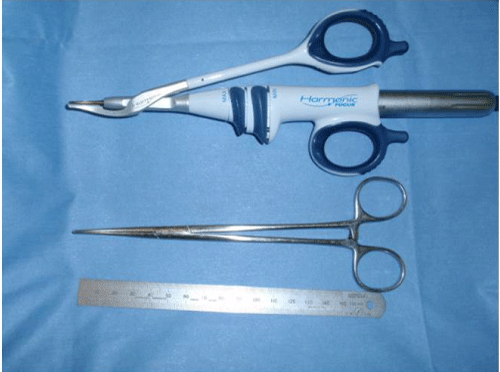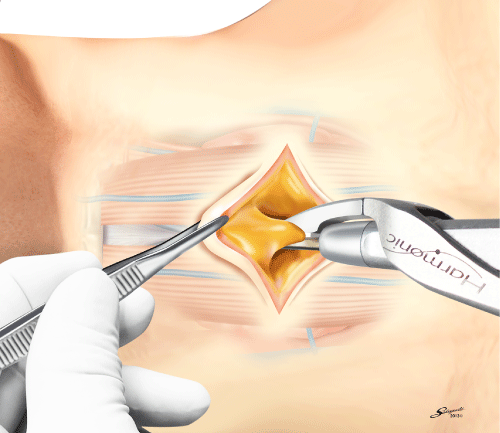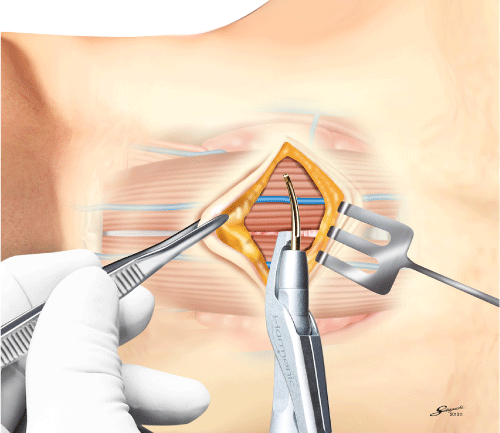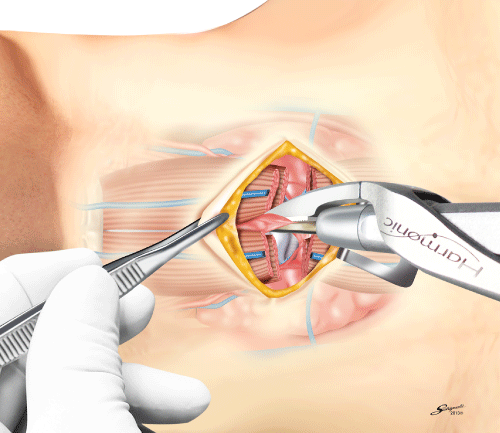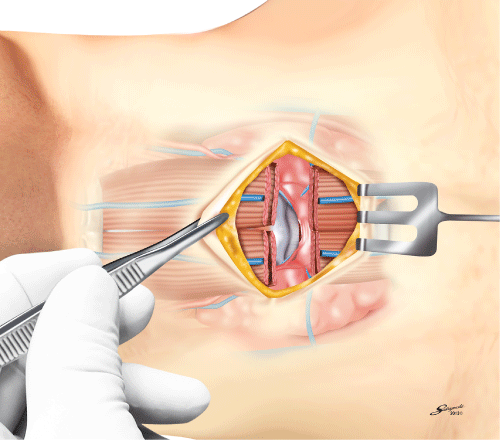Technique of Harmonic Focus In Tracheostomy
Received: 09-Feb-2014 / Accepted Date: 20-Feb-2014 / Published Date: 27-Feb-2014 DOI: 10.4172/2161-119X.1000160
Abstract
Objectives: The purpose of the present study was to show the technique of the Harmonic FOCUS® Cured Shears (HF) in tracheostomy in the shortest possible period of time.
Methods: Patients were 10 individuals who had undergone tracheostomy at Tokyo Medical University Hachioji Medical Center. HF was used in the all 10 patients. A skin incision was made in the inferior margin of the cricoid cartilage, and FOCUS® was used from treatment of subcutaneous fat onwards. FOCUS® was used both to dissect the subcutaneous fat, as well as the anterior muscles of the neck and anterior jugular vein, and to seal these parts. The pyramidal lobe of the thyroid gland was transected at a height directly below the cricoid cartilage, and the trachea was reached.
Results: The mean time taken to reach the trachea was 93.1 s (range, 63-115 s). Conclusions: The HF is useful for tracheostomy and enables an airway to be secured within a short period of time.
Keywords: Harmonic focus, Tracheostomy, Short time, Energy device
257551Introduction
Securing an airway is of utmost importance in preserving life. Among patients in whom oral intubation is difficult due to upper airway obstruction, an airway must be secured transdermally and as quickly as possible. Cricothyrotomy, which is performed in extreme emergencies, can lead to dysarthria as a result of cricothyroid muscle damage; therefore, regular tracheostomy should be selected when possible. For this reason, tracheostomy is one of the most important procedures in the fields of head and neck surgery and otolaryngology. The established procedure for tracheostomy involves separating the strap muscles in the midline. From our knowledge of anatomy that has been built up over a long period of time, we know that such an approach will minimize hemorrhage from the anterior jugular vein, anterior neck muscles and thyroid [1].
In recent years, rapid advances have been achieved in surgical instruments for this purpose. The Harmonic Scalpel® (HS) (Ethicon Endo-Surgery Inc., Cincinnati, OH) is a new device that has been introduced into surgery during the last decade. It has a blade that vibrates at 55.5 kHz over a distance of 80 μm [2]. It denatures protein through the use of ultrasonic vibration, transferring mechanical energy in amounts that are able to break tertiary hydrogen bonds [3].
The denatured protein subsequently forms a sticky coagulum. The Harmonic FOCUS® Cured Shears (HF) (Ethicon Endo-Surgery), introduced in 2009, represent the latest model of the scalpel. They are similar to the Kelly forceps both in shape and in the way they are manipulated (Figure 1). They are able to seal tissue, including blood vessels, up to 5 mm in diameter, and their shape is well-suited to head and neck surgery. All tissues at the height of the anterior trachea and inferior cricoid cartilage, including fat, anterior muscles of the neck, and pyramidal lobe of the thyroid gland, are dissected and sealed by the HF; therefore, there is no need for concern about sites of anatomical hemorrhage because the trachea may be reached within a short space of time. The purpose of the present study was to show the technique of the HF in tracheostomy with regard to securing an airway in the shortest possible period of time.
Materials and Methods
Patients were 10 individuals who had undergone tracheostomy in the Department of Head and Neck Surgery at Tokyo Medical University Hachioji Medical Center between October 2012 and January 2013. All patients had been previously operated on by the first author (Table 1). HF was used in the all 10 patients. All patients were male, with a mean age of 69.8 years at the time of surgery (range, 59-87 years). Mean Body Mass Index (BMI) was 20.5 (range, 12-28). Underlying pathology was hypo pharyngeal cancer in 5 cases, mesopharyngeal cancer in 2 cases, laryngeal cancer in 2 cases and maxillary sinus cancer in 1 case. The procedure was conducted under general anesthesia in 8 patients and under local anesthesia in 2 patients.
| Case | Age (y) | Sex | Disease | BMI (kg/m2) | Operation time (s) |
|---|---|---|---|---|---|
| 1 | 83 | Male | HPC | 23 | 85 |
| 2 | 72 | Male | HPC | 21 | 98 |
| 3 | 63 | Male | HPC | 21 | 63 |
| 4 | 69 | Male | LC | 28 | 115 |
| 5 | 87 | Male | HPC | 20 | 95 |
| 6 | 75 | Male | LC | 22 | 104 |
| 7 | 63 | Male | MSC | 17 | 98 |
| 8 | 66 | Male | MPC | 22 | 100 |
| 9 | 59 | Male | MPC | 19 | 88 |
| 10 | 61 | Male | HPC | 12 | 85 |
HPC: Hypopharyngeal Cancer; LC: Laryngeal Cancer; MPC:Mesopharynbeal Cancer; MSC: Maxillary Sinus Cancer
Table 1: Patient characteristics and Operation Time.
A skin incision was made in the inferior margin of the cricoid cartilage, and FOCUS® was used from treatment of subcutaneous fat onwards. FOCUS® was used both to dissect the subcutaneous fat (Figure 2), as well as the anterior muscles of the neck and anterior jugular vein, and to seal these parts (Figure 3). The pyramidal lobe of the thyroid gland was transected (Figure 4) at a height directly below the cricoid cartilage, and the trachea was reached (Figure 5).
The time taken to reach the trachea from making the skin incision was measured. The study was approved by the ethics committee of Tokyo Medical University’s Hachioji Medical Center. We have no financial disclosure in this study.
Results
The mean time taken to reach the trachea was 93.1 s (range, 63-115 s) (Table 1). No complications were observed in any patient.
Discussion
HS has been used in laparoscopic surgery and its application expanded to open surgery. HS has been extensively used as an alternative surgical tool for dissection and achieves perfect hemostasis, particularly in minimally invasive surgery, but the use of HS in open surgery has been limited as the design of the device is uncomfortable for the surgeon [4,5]. However, with a similar form to Kelly forceps, HF is suitable for open surgery, and its usefulness in terms of decreased hemorrhage and shortened operation time has been widely reported in areas such as thyroidectomy, liver transection, and breast cancer [5-8]. In a randomized study of 200 patients who underwent thyroid operation, Ortega et al. [7] reported a 15-20% reduction in operation time. HF is also suited to tracheostomy. In the current subjects, mean procedure time was 93.1 s. In cases in which the urgency of securing the airway is great, every second of operating time counts. This is therefore an important result.
The tissues at the height of the anterior trachea and inferior cricoid cartilage are fat, the anterior jugular vein, anterior neck muscles and the pyramidal lobe of the thyroid gland. With the use of HF to dissect and seal these tissues, no dysarthria, swallowing defects, or other functional damage will result, and use of the HF for this purpose allows an airway to be secured within a short period of time. However, it is important to confirm the thyroid cartilage and trachea by palpation when using the HF. Resection of the anterior surface of the trachea will usually cause no complications, but a risk of damage to the recurrent laryngeal nerve does exist with blind dissection of paratracheal tissue with the HF. This approach is effective in cases where palpation reveals displacement of the trachea due to lesions such as large thyroid tumor. The present study examined the time to reach the trachea from the inferior margin of the cricoid cartilage, but tracheostomy at any height would be possible by splitting the thyroid with HF. Gohtoda et al. [8] noted that hepatectomy using the HF was performed safely even when the surgeon was a trainee. Based on the present procedure, the HF could be used safely in tracheostomy to secure an airway within a short period of time by large numbers of surgeons.
Conclusion
The HF is useful for tracheostomy and enables an airway to be secured within a short period of time.
References
- Lore JM Jr, Medina JE (2005) An Atlas of Head & Neck Surgery. (4th Edn) Philadelphia, PA: Elsevier Saunder. Pp 1015–1019.
- McCarus SD (1996) Physiologic mechanism of the ultrasonically activated scalpel. J Am Assoc Gynecol Laparosc 3: 601-608.
- Walker RA, Syed ZA (2001) Harmonic scalpel tonsillectomy versus electrocautery tonsillectomy: a comparative pilot study. Otolaryngol Head Neck Surg 125: 449-455.
- Aponte-Rueda ME, Saade Cárdenas RA, Saade Aure MJ (2009) Endoscopic axillary dissection: a systematic review of the literature. Breast 18: 150-158.
- He Q, Zhuang D, Zheng L, Fan Z, Zhou P, et al. (2012) Harmonic focus versus electrocautery in axillary lymph node dissection for breast cancer: a randomized clinical study. Clin Breast Cancer 12: 454-458.
- Ferri E, Armato E, Spinato G, Spinato R (2011) Focus harmonic scalpel compared to conventional haemostasis in open total thyroidectomy: a prospective randomized trial. Int J Otolaryngol.
- Ortega J, Sala C, Flor B, Lledo S (2004) Efficacy and cost-effectiveness of the UltraCision harmonic scalpel in thyroid surgery: an analysis of 200 cases in a randomized trial. J Laparoendosc Adv Surg Tech A 14: 9-12.
- Gotohda N, Konishi M, Takahashi S, Kinoshita T, Kato Y, et al. (2012) Surgical outcome of liver transection by the crush-clamping technique combined with Harmonic FOCUSâ„¢. World J Surg 36: 2156-2160.
Citation: Tsukahara K, Nakamura K, Motohashi R, Sato H, Suzuki M, et al. (2014) Technique of Harmonic Focus® In Tracheostomy. Otolaryngology 4:160. DOI: 10.4172/2161-119X.1000160
Copyright: © 2014 Tsukahara K, et al. This is an open-access article distributedunder the terms of the Creative Commons Attribution License, which permits unrestricted use, distribution, and reproduction in any medium, provided the original author and source are credited.
Share This Article
Recommended Journals
Open Access Journals
Article Tools
Article Usage
- Total views: 15563
- [From(publication date): 5-2014 - Apr 07, 2025]
- Breakdown by view type
- HTML page views: 10921
- PDF downloads: 4642

